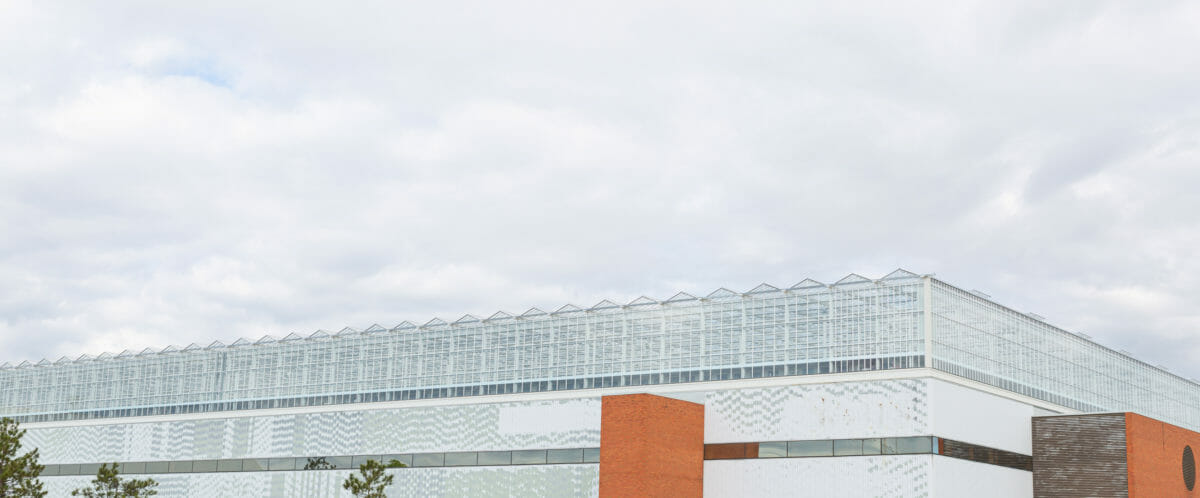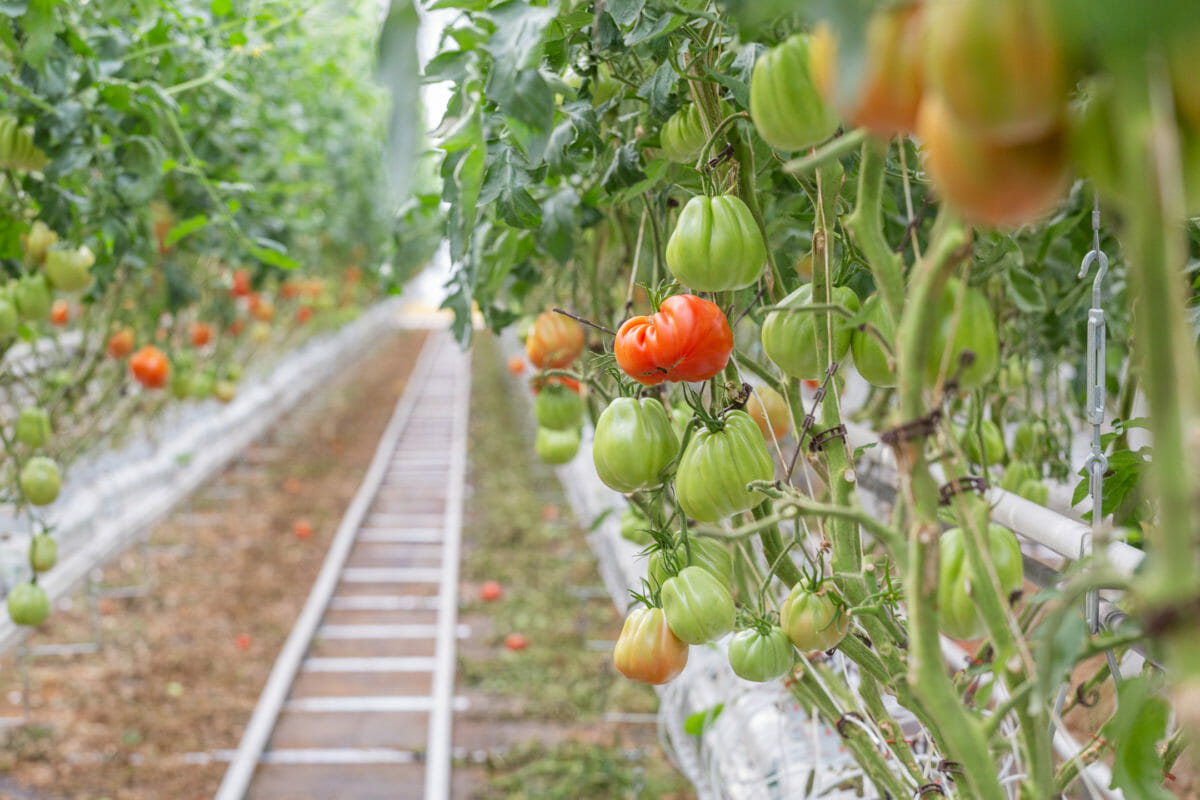World’s Largest Rooftop Greenhouse Opens In Quebec
The farm produces 25,000 pounds of produce each week.
World’s Largest Rooftop Greenhouse Opens In Quebec
The farm produces 25,000 pounds of produce each week.

Lufa Farms' newest facility is the largest rooftop greenhouse in the world.courtesy of Lufa Farms
The battle to be considered the world’s largest non-traditional farm—hydroponic, rooftop, aeroponic—is never-ending.
But last week, Quebec company Lufa Farms unveiled its fourth rooftop farm, which is absolutely enormous—enormous enough to hold the title of world’s largest rooftop greenhouse farm.
Urban roofs have long been seen as essentially wasted space. These rooftops contain massive amounts of effectively unused land, typically between 15 and 35 percent of the entire city’s square footage. Because they are exposed to the sun, they’ve been commonly used for solar panels, as well as for telecommunications antennae, but agriculture has also taken note.
Rooftop farms have the advantage of being located closer to major population centers than any traditional farm possibly could be, but they also come with difficulties. There are weight restrictions, and crops with significant soil needs, such as fruit trees, generally aren’t seen as sensible to grow up high. But some farms, like Brooklyn Grange in New York City’s Brooklyn Navy Yard, function as educational organizations in addition to commercial farms, lessening their need for efficiency. Others, including many greenhouse rooftop farms, use hydroponics, which can be a more efficient use of space.

Lufa Farms has four hydroponic farms, located in rooftop greenhouses around the island of Montreal. Its latest, this enormous one, is located in Montreal, west of downtown, in a borough called Ville Saint-Laurent. It clocks in at 163,800 square feet, a little less than the area of three football fields. (Given that this is a Canadian company, we should clarify that those are American football fields, and that this is equal to about 9.5 NHL-sized hockey rinks.)
This August, that Ville Saint-Laurant farm reached full production, which includes 10 varieties of tomato and three varieties of eggplant. The company says this farm can produce 25,000 pounds of produce per week, a massive number, and that it will continue to be operational year round despite the chilly climate. That’s done with the help of various tactics, including blackout curtains and double-paned glass. The farm also includes a rainwater capture system, to be fed into its recirculating hydroponic setup.
Lufa’s business model is more consumer-focused than many urban farms; instead of selling to restaurants and grocery stores, the company operates a subscription box, with pickup locations all around the city. In an interview with the Montreal Gazette, one of the cofounders said that the company is profitable, and certainly the expansion of the company has taken off in the wake of the COVID-19 pandemic. Lufa says that its home delivery tripled during the pandemic.
Follow us
This work is licensed under a Creative Commons Attribution-NoDerivatives 4.0 International License.
Want to republish a Modern Farmer story?
We are happy for Modern Farmer stories to be shared, and encourage you to republish our articles for your audience. When doing so, we ask that you follow these guidelines:
Please credit us and our writers
For the author byline, please use “Author Name, Modern Farmer.” At the top of our stories, if on the web, please include this text and link: “This story was originally published by Modern Farmer.”
Please make sure to include a link back to either our home page or the article URL.
At the bottom of the story, please include the following text:
“Modern Farmer is a nonprofit initiative dedicated to raising awareness and catalyzing action at the intersection of food, agriculture, and society. Read more at <link>Modern Farmer</link>.”
Use our widget
We’d like to be able to track our stories, so we ask that if you republish our content, you do so using our widget (located on the left hand side of the article). The HTML code has a built-in tracker that tells us the data and domain where the story was published, as well as view counts.
Check the image requirements
It’s your responsibility to confirm you're licensed to republish images in our articles. Some images, such as those from commercial providers, don't allow their images to be republished without permission or payment. Copyright terms are generally listed in the image caption and attribution. You are welcome to omit our images or substitute with your own. Charts and interactive graphics follow the same rules.
Don’t change too much. Or, ask us first.
Articles must be republished in their entirety. It’s okay to change references to time (“today” to “yesterday”) or location (“Iowa City, IA” to “here”). But please keep everything else the same.
If you feel strongly that a more material edit needs to be made, get in touch with us at [email protected]. We’re happy to discuss it with the original author, but we must have prior approval for changes before publication.
Special cases
Extracts. You may run the first few lines or paragraphs of the article and then say: “Read the full article at Modern Farmer” with a link back to the original article.
Quotes. You may quote authors provided you include a link back to the article URL.
Translations. These require writer approval. To inquire about translation of a Modern Farmer article, contact us at [email protected]
Signed consent / copyright release forms. These are not required, provided you are following these guidelines.
Print. Articles can be republished in print under these same rules, with the exception that you do not need to include the links.
Tag us
When sharing the story on social media, please tag us using the following: - Twitter (@ModFarm) - Facebook (@ModernFarmerMedia) - Instagram (@modfarm)
Use our content respectfully
Modern Farmer is a nonprofit and as such we share our content for free and in good faith in order to reach new audiences. Respectfully,
No selling ads against our stories. It’s okay to put our stories on pages with ads.
Don’t republish our material wholesale, or automatically; you need to select stories to be republished individually.
You have no rights to sell, license, syndicate, or otherwise represent yourself as the authorized owner of our material to any third parties. This means that you cannot actively publish or submit our work for syndication to third party platforms or apps like Apple News or Google News. We understand that publishers cannot fully control when certain third parties automatically summarize or crawl content from publishers’ own sites.
Keep in touch
We want to hear from you if you love Modern Farmer content, have a collaboration idea, or anything else to share. As a nonprofit outlet, we work in service of our community and are always open to comments, feedback, and ideas. Contact us at [email protected].by Dan Nosowitz, Modern Farmer
September 2, 2020
Modern Farmer Weekly
Solutions Hub
Innovations, ideas and inspiration. Actionable solutions for a resilient food system.
ExploreShare With Us
We want to hear from Modern Farmer readers who have thoughtful commentary, actionable solutions, or helpful ideas to share.
SubmitNecessary cookies are absolutely essential for the website to function properly. This category only includes cookies that ensures basic functionalities and security features of the website. These cookies do not store any personal information.
Any cookies that may not be particularly necessary for the website to function and are used specifically to collect user personal data via analytics, ads, other embedded contents are termed as non-necessary cookies.
I am the commercial manager of a company in Iran. But I emailed you from my personal email. In actually, I plan to do a project in the field of greenhouse (hydroponic) fruit and vegetable production. And I need an investor. The good connections I have in the government, provide me with agricultural land/water/electricity/gas / low-interest loans / and so on. This land is approximately 120 hectares and a large greenhouse can be built. Of course, part of these products enters the domestic market and another part is exported. In the first stage, the design can be started in small… Read more »